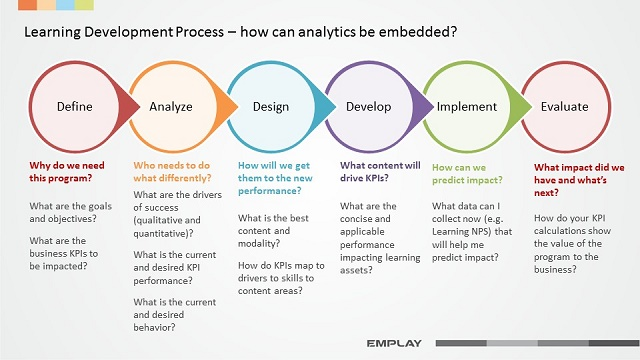ATD Blog
Learning Analytics: What Does Data Science Have to Do With Learning?
Fri Nov 06 2015

Advances in big data, analytics, and data science—combined with massive computer processing power and the efficiency gains of the cloud—have given us powerful tools to take our organizations to the next level through talent development solutions.
The journey begins with knowing what we want to achieve and putting in place the appropriate methods and tools to support these goals. Learning analytics is one enabler that forward-thinking learning organizations are applying to their talent development practices.
Getting Proactive With Learning Metrics
Learning analytics is not, as it is often defined, simply an offshoot of learning impact analysis. Impact analysis provides results "after the fact," which often leaves talent development professionals scrambling for metrics to prove the business impact of talent development programs.
Learning analytics does more than put a nice bow on a package of metrics. It goes beyond traditional impact measures to consider the power of data to answer critical questions throughout the talent development process:
Why do we need this program?
Who needs to do what differently?
How will we get them to the new performance?
What content will drive KPIs?
How can we predict impact?
What impact did we have and what’s next?
By traversing the talent development process (analyze, design, develop, implement, and evaluate) and adding a new step (define), we can garner data-driven insights to these critical questions which enable learning executives to deliver better and more targeted business results. If we fail at this integration, however, the continued complexity of “after-the-fact” impact analysis will likely send professionals rushing back to spreadsheets and surveys—those familiar but low-insight-yielding tools for tracking results.
That’s why proactive metrics design is such a critical component of any learning analytics initiative. Metrics definition sets the stage for the whys of strategic learning programs.
Embedding Learning Analytics for Better Outcomes
Embedding learning analytics in the talent development process means making insights not only actionable, but also measurable. This requires measuring effectiveness from a people, customer, and revenue perspective.
As a talent development leader, the days of being measured on the number of training hours produced are quickly waning. In the very near future, you will be measured on organizationally aligned results that analytics can help you produce by extracting insight from each phase of your talent development process and every learner within your programs.
This diagram illustrates a popular training development process. The real-world examples that follow demonstrate some of the ways in which learning analytics can power the outcomes across the process.

Case in point: When a global software leader with significant investments in leadership development decided to reimagine its leadership training program, the company stopped to examine the KPIs necessary for the leadership program to have the desired impact. As a result, they were able to clearly articulate to their business stakeholders which programs need sponsorship and why, and then define the KPIs the program would impact.
The organization’s learning executives defined eight KPIs that needed to be improved in order for the program to be deemed a success. These KPIs ranged from financial indicators, like margins and growth metrics, to HR KPIs, like retention, ESAT, diversity, and succession pipeline. This exercise helped the business identify the program components to be added based on their likelihood of a positive impact the outcomes quantitatively.
Leading With Learning Analytics
Analytics can deliver, prove, and demonstrate the business value of learning strategies and programs from the corner office to the back office. For today’s talent development executives, it’s imperative to keep pace with the business by leveraging big data to uncover and address problems and deliver results. By applying talent analytics, these executives can deliver highly personalized programs that reduce costs and in increase retention.
As you consider how learning analytics can be applied to your talent development function, and to the organization as a whole, stay tuned to this series over the coming months. Together we will explore the program phases and suggest methods and tools you can put into practice to amplify the success of your talent development organization.
Read more from Sanchita Sur in the ASTD Handbook, 2nd Edition.
